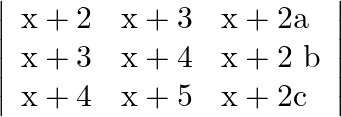Correct option is (A)0
Given ![]() are in A.P.
are in A.P.
![]()
![Rendered by QuickLaTeX.com \[\left|\begin{array}{lll} \mathrm{x}+2 & \mathrm{x}+3 & \mathrm{x}+2 \mathrm{a} \\ \mathrm{x}+3 & \mathrm{x}+4 & \mathrm{x}+2 \mathrm{~b} \\ \mathrm{x}+4 & \mathrm{x}+5 & \mathrm{x}+2 \mathrm{c} \end{array}\right|\]](https://www.learnatnoon.com/s/wp-content/ql-cache/quicklatex.com-fc096b976673bd8b34bf1d771ae70b94_l3.png)
![Rendered by QuickLaTeX.com \[\begin{array}{l} \mathrm{R}_{1} \rightarrow \mathrm{R}_{1}+\mathrm{R}_{3} \\ \left|\begin{array}{ccc} 2(\mathrm{x}+3) & 2(\mathrm{x}+4) & 2 \mathrm{x}+2(\mathrm{a}+\mathrm{c}) \\ \mathrm{x}+3 & \mathrm{x}+4 & \mathrm{x}+2 \mathrm{~b} \\ \mathrm{x}+4 & \mathrm{x}+5 & \mathrm{x}+2 \mathrm{c} \end{array}\right| \end{array}\]](https://www.learnatnoon.com/s/wp-content/ql-cache/quicklatex.com-edde0691440b230fd6b0c41304d5dfa8_l3.png)
![Rendered by QuickLaTeX.com \[\left|\begin{array}{ccc} 2(x+3) & 2(x+4) & 2 x+4 b \\ x+3 & x+4 & x+2 b \\ x+4 & x+5 & x+2 c \end{array}\right| \quad \text { (by (1)) }\]](https://www.learnatnoon.com/s/wp-content/ql-cache/quicklatex.com-4500b03f3282a21ce2c358249a987309_l3.png)
![Rendered by QuickLaTeX.com \[=2\left|\begin{array}{lll} \mathrm{x}+3 & \mathrm{x}+4 & \mathrm{x}+2 \mathrm{~b} \\ \mathrm{x}+3 & \mathrm{x}+4 & \mathrm{x}+2 \mathrm{~b} \\ \mathrm{x}+4 & \mathrm{x}+5 & \mathrm{x}+2 \mathrm{c} \end{array}\right|\]](https://www.learnatnoon.com/s/wp-content/ql-cache/quicklatex.com-fbba0bd3b6b9e9f50ab1978b92d0cbff_l3.png)
Since, ![]() are identical, the value of determinant is 0 .
are identical, the value of determinant is 0 .
 is
is  is
is Correct option is (A)0
Given ![]() are in A.P.
are in A.P.
![]()
![Rendered by QuickLaTeX.com \[\left|\begin{array}{lll} \mathrm{x}+2 & \mathrm{x}+3 & \mathrm{x}+2 \mathrm{a} \\ \mathrm{x}+3 & \mathrm{x}+4 & \mathrm{x}+2 \mathrm{~b} \\ \mathrm{x}+4 & \mathrm{x}+5 & \mathrm{x}+2 \mathrm{c} \end{array}\right|\]](https://www.learnatnoon.com/s/wp-content/ql-cache/quicklatex.com-fc096b976673bd8b34bf1d771ae70b94_l3.png)
![Rendered by QuickLaTeX.com \[\begin{array}{l} \mathrm{R}_{1} \rightarrow \mathrm{R}_{1}+\mathrm{R}_{3} \\ \left|\begin{array}{ccc} 2(\mathrm{x}+3) & 2(\mathrm{x}+4) & 2 \mathrm{x}+2(\mathrm{a}+\mathrm{c}) \\ \mathrm{x}+3 & \mathrm{x}+4 & \mathrm{x}+2 \mathrm{~b} \\ \mathrm{x}+4 & \mathrm{x}+5 & \mathrm{x}+2 \mathrm{c} \end{array}\right| \end{array}\]](https://www.learnatnoon.com/s/wp-content/ql-cache/quicklatex.com-edde0691440b230fd6b0c41304d5dfa8_l3.png)
![Rendered by QuickLaTeX.com \[\left|\begin{array}{ccc} 2(x+3) & 2(x+4) & 2 x+4 b \\ x+3 & x+4 & x+2 b \\ x+4 & x+5 & x+2 c \end{array}\right| \quad \text { (by (1)) }\]](https://www.learnatnoon.com/s/wp-content/ql-cache/quicklatex.com-4500b03f3282a21ce2c358249a987309_l3.png)
![Rendered by QuickLaTeX.com \[=2\left|\begin{array}{lll} \mathrm{x}+3 & \mathrm{x}+4 & \mathrm{x}+2 \mathrm{~b} \\ \mathrm{x}+3 & \mathrm{x}+4 & \mathrm{x}+2 \mathrm{~b} \\ \mathrm{x}+4 & \mathrm{x}+5 & \mathrm{x}+2 \mathrm{c} \end{array}\right|\]](https://www.learnatnoon.com/s/wp-content/ql-cache/quicklatex.com-fbba0bd3b6b9e9f50ab1978b92d0cbff_l3.png)
Since, ![]() are identical, the value of determinant is 0 .
are identical, the value of determinant is 0 .